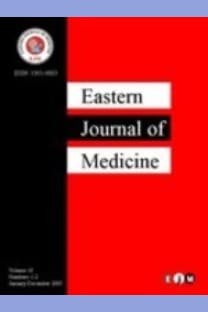Idiopathic intracranial hypertension in adolescents with severe visual impairment: Long-term outcome and the beneficial effects of weight loss and psychological support.
Idiopathic intracranial hypertension in adolescents with severe visual impairment: Long-term outcome and the beneficial effects of weight loss and psychological support.
Adolescents, pseudotumor cerebri, treatment, vision, weight loss,
___
- Friedman DI, Jacobson DM. Diagnostic criteria for idiopathic intracranial hypertension. Neurology 2002; 59: 1492-1495.
- Baker RS, Carter D, Hendrick EB, Buncic JR. Visual loss in pseudotumor cerebri of childhood. A follow-up study. Arch Ophthalmol 1985; 103: 1681-1686.
- Grant DN. Benign intracranial hypertension. A review of 79 cases in infancy and childhood. Arch Dis Child 1971; 46: 651-655.
- Soler D, Cox T, Bullock P, Calver DM, Robinson RO. Diagnosis and management of benign intracranial hypertension. Arch Dis Child 1998; 78: 89-94.
- Sugerman HJ, DeMaria EJ, Felton WL, 3rd Nakatsuka M, Sismanis A. Increased intra-abdominal pressure and cardiac filling pressures in obesity-associated pseudotumor cerebri. Neurology 1997; 49: 507-511.
- Cole TJ, Bellizzi MC, Flegal KM, Dietz WH. Establishing a standard definition for child overweight and obesity worldwide:international survey. BMJ 2000; 320: 1-6.
- Gordon K. Pediatric pseudotumor cerebri: descriptive epidemiology. Can J Neurol Sci 1997; 24: 219-221.
- Cinciripini GS, Donahue S. Borchert MS. Idiopathic intracranial hypertension in prepubertal pediatric patients: characteristics, treatment, and outcome. Am J Ophthalmol 1999; 127: 178-182.
- Distelmaier F, Sengler U, Messing-Juenger M, et al. Pseudotumor cerebri as an important differential diagnosis of papilledema in children. Brain Dev 2006; 28: 190-195.
- Rangwala LM, Liu GT. Pediatric idiopathic intracranial hypertension. Surv Ophthalmol 2007; 52: 597-617.
- Mehta SR, Afenyi-Annan A, Byrns PJ, Lottenberg R. Opportunities to improve outcomes in sickle cell disease. Am Fam Physician 2006; 74: 303-310.
- Razumovsky AY, Gillard JH, Bryan RN, Hanley DF, Oppenheimer SM. TCD, MRA and MRI in acute cerebral ischemia. Acta Neurol Scand 1999; 99: 65- 76.
- Binder DK, Horton JC, Lawton MT, McDermott MW. Idiopathic intracranial hypertension. Neurosurgery 2004; 54: 538-551.
- Liu GT, Glaser JS, Schatz NJ. High-dose methylprednisolone and acetazolamide for visual loss in pseudotumor cerebri. Am J Ophthalmol 1994; 118: 88-96.
- ISSN: 1301-0883
- Yayın Aralığı: 4
- Başlangıç: 1996
- Yayıncı: ERBİL KARAMAN
Thrombocytopenia due to the use of rifampicin in brucellosis
Cengiz DEMİR, Refah SAYIN, Yasemin SOYORAL, Mustafa Kasım KARAHOCAGİL
Parwez Sajad KHAN, Humera HAYAT, Majid MUSHTAQUE, Latif Ahmad DAR
Garoufi ANASTASİA, Georgouli HELEN, Vartzelis GEORGE, Eliades ANDREAS, Velissariou JOANNA, Kossiva LYDİA
Salman JAVED, Mustafa ZABOLİ, Alveena ZEHRA, Naima SHAH
Chandan Kumar SHAW, Prachi SHAW, Tejesh MALLA, Kalpana K. MALLA
Anasarca-an atypical presentation of hepatitis A
Sudip SAHA, Madhusmita SENGUPTA
A girl presenting with intractable seizure and decreased visual acuity
Çelebi KOCAOĞLU, Fatih AKIN, Ahmet SERT, Hüseyin ÇAKSEN, Vefa ÖNER, Cengizhan KILIÇASLAN, Şükrü ARSLAN
A case report of multiple left anterior descending coronary artery-left ventricular microfistulae
Murat CELİK, Mustafa TUNCER, Nurullah TUZUN
Yasemin Usul SOYORAL, Huseyin BEGENİK, Ramazan ESEN, İmdat DİLEK, Ahmet Cumhur DULGER, Levent DEMİRTAS, Reha ERKOC
What residents should know before starting inpatient psychiatry?
Racha NAZİR, Basappa VENKATESH, Ahmad S. BASHİR, Karim SEDKY, Steven LİPPMANN
